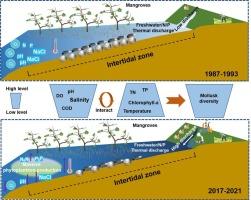Interactions of multiple abiotic stresses exacerbate mollusk diversity loss in a high-discharge coastal mangrove wetland
IF 4.9
3区 环境科学与生态学
Q1 ENVIRONMENTAL SCIENCES
引用次数: 0
Abstract
Coastal regions, as a hotspot region of biodiversity and the most densely populated areas in the world, are increasingly threatened by anthropogenic disturbances, including warming, acidification, eutrophication, salinity fluctuation, and oxygen loss. Although massive single-factor studies have revealed the ecological catastrophe caused by these impacts, how these impact stressors interact to endanger coastal biodiversity that is critical for ecosystem stability and human well-being is still poorly understood. To investigate whether and how water warming, acidification, eutrophication, salinity fluctuation and oxygen loss interact with each other to impact the mangrove mollusk diversity, a long-term study was conducted in the mangroves of Chinese Daya Bay from 1987–1993 to 2017–2021. We found that water temperature, chlorophyll-a, total nitrogen (TN) and total phosphorus (TP) increased significantly, while the water pH, salinity, dissolved oxygen (DO) and mollusk species richness decreased obviously, reflecting water warming, eutrophication, acidification, salinity fluctuation, oxygen loss and biodiversity loss occurred in the Daya Bay. The mangrove mollusk diversity had a significant response to the water warming, eutrophication, acidification, salinity fluctuation, oxygen loss (p < 0.001). The average incidences of mollusk diversity loss due to the changes in water pH, temperature, TP, TN, chlorophyll-a, salinity and DO were 47.11 %, 35.56 %, 35.53 %, 34.48 %, 34.22 %, 34.15 % and 33.05 %, respectively. Moreover, the average effect of interactions between any two water factors on the mollusk diversity was 0.998, which was 22.5 % larger than their single effect on biodiversity of 0.814. The findings suggest that interactions between global change stressors can exacerbate biodiversity loss in coastal wetlands. Quantifying those effects in terms of multi-factor interactions will contribute to the coastal management and restoration based upon combined evidence rather than a one-sided single perspective.

多种非生物胁迫的相互作用加剧了高流量滨海红树林湿地软体动物多样性的丧失。
沿海地区作为世界上生物多样性的热点地区和人口最密集的地区,日益受到气候变暖、酸化、富营养化、盐度波动和氧气损失等人为干扰的威胁。尽管大量的单因素研究已经揭示了这些影响造成的生态灾难,但这些影响压力源如何相互作用,危及对生态系统稳定和人类福祉至关重要的沿海生物多样性,人们仍然知之甚少。为了研究海水变暖、酸化、富营养化、盐度波动和氧气损失是否以及如何相互作用影响红树林软体动物多样性,1987-1993年至2017-2021年对中国大亚湾红树林进行了长期研究。结果表明,大亚湾水温、叶绿素-a、总氮(TN)和总磷(TP)显著升高,水体pH、盐度、溶解氧(DO)和软体动物物种丰富度明显下降,反映了水体增温、富营养化、酸化、盐度波动、氧气损失和生物多样性丧失。红树林软体动物多样性对水体变暖、富营养化、酸化、盐度波动、氧损失有显著的响应
本文章由计算机程序翻译,如有差异,请以英文原文为准。
求助全文
约1分钟内获得全文
求助全文
来源期刊

Marine pollution bulletin
环境科学-海洋与淡水生物学
CiteScore
10.20
自引率
15.50%
发文量
1077
审稿时长
68 days
期刊介绍:
Marine Pollution Bulletin is concerned with the rational use of maritime and marine resources in estuaries, the seas and oceans, as well as with documenting marine pollution and introducing new forms of measurement and analysis. A wide range of topics are discussed as news, comment, reviews and research reports, not only on effluent disposal and pollution control, but also on the management, economic aspects and protection of the marine environment in general.
 求助内容:
求助内容: 应助结果提醒方式:
应助结果提醒方式:


